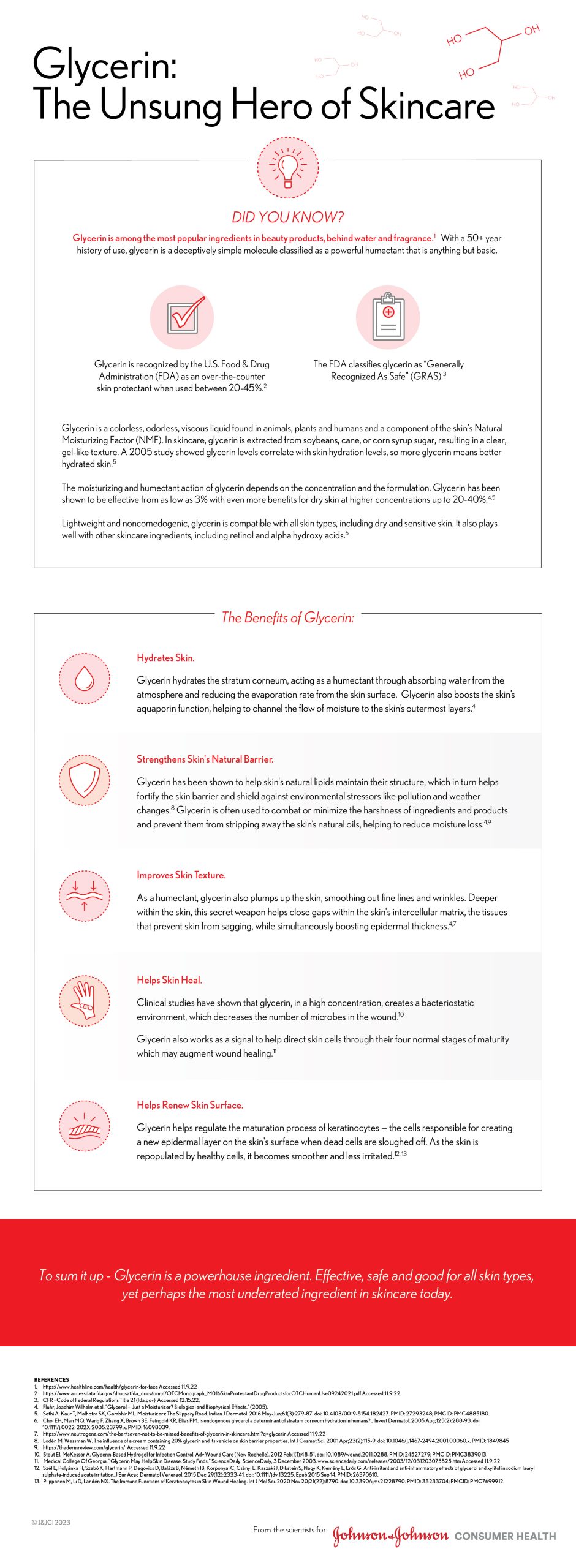DID YOU KNOW?
Glycerin is among the most popular ingredients in beauty products, behind water and fragrance.1 With a 50+ year history of use, glycerin is a deceptively simple molecule classified as a powerful humectant that is anything but basic.
-
- Glycerin is recognized by the U.S. Food & Drug Administration (FDA) as an over-the-counter skin protectant when used between 20-45%.2
- The FDA classifies glycerin as “Generally Recognized as Safe (GRAS).3
Glycerin is a colorless, odorless, viscous liquid found in animals, plants and humans and a component of the skin’s Natural Moisturizing Factor (NMF). In skincare, glycerin is extracted from soybeans, cane, or corn syrup sugar, resulting in a clear, gel-like texture. A 2005 study showed glycerin levels correlate with skin hydration levels, so more glycerin means better hydrated skin.4
The moisturizing and humectant action of glycerin depends on the concentration and the formulation. Glycerin has been shown to be effective from as low as 3% with even more benefits for dry skin at higher concentrations up to 20-40%.3,4
Lightweight and noncomedogenic, glycerin is compatible with all skin types, including dry and sensitive skin. It also plays well with other skincare ingredients, including retinol and alpha hydroxy acids.5
The Benefits of Glycerin
Hydrates Skin
Glycerin hydrates the stratum corneum, acting as a humectant through absorbing water from the atmosphere and reducing the evaporation rate from the skin surface. Glycerin also boosts the skin’s aquaporin function, helping to channel the flow of moisture to the skin’s outermost layers.4
Strengthens Skin’s Natural Barrier
Glycerin has been shown to help skin’s natural lipids maintain their structure, which in turn helps fortify the skin barrier and shield against environmental stressors like pollution and weather changes.8 Glycerin is often used to combat or minimize the harshness of ingredients and products and prevent them from stripping away the skin’s natural oils, helping to reduce moisture loss.4,9
Improves Skin Texture
As a humectant, glycerin also plumps up the skin, smoothing out fine lines and wrinkles. Deeper within the skin, this secret weapon helps close gaps within the skin’s intercellular matrix, the tissues that prevent skin from sagging, while simultaneously boosting epidermal thickness.4,7
Helps Skin Heal
Clinical studies have shown that glycerin, in a high concentration, creates a bacteriostatic environment, which decreases the number of microbes in the wound.10
Glycerin also works as a signal to help direct skin cells through their four normal stages of maturity which may augment wound healing for people with diseases such as psoriasis and non-melanoma skin cancers, which result from abnormal proliferation and maturation of skin cells.11
Helps Renew Skin Surface
Glycerin helps regulate the maturation process of keratinocytes — the cells responsible for creating a new epidermal layer on the skin’s surface when dead cells are sloughed off. As the skin is repopulated by healthy cells, it becomes smoother and less irritated.12,13
To sum it up – Glycerin is a powerhouse ingredient. Effective, safe and good for all skin types, yet perhaps the most underrated ingredient in skincare today.
Learn more by downloading the infographic below

References
-
- https://www.healthline.com/health/glycerin-for-face Accessed 11.9.22
- https://www.accessdata.fda.gov/drugsatfda_docs/omuf/OTCMonograph_M016SkinProtectantDrugProductsforOTCHumanUse09242021.pdf Accessed 11.9.22
- CFR – Code of Federal Regulations Title 21 (fda.gov) Accessed 12.15.22.
- Fluhr, Joachim Wilhelm et al. “Glycerol — Just a Moisturizer? Biological and Biophysical Effects.” (2005).
- Sethi A, Kaur T, Malhotra SK, Gambhir ML. Moisturizers: The Slippery Road. Indian J Dermatol. 2016 May-Jun;61(3):279-87. doi: 10.4103/0019-5154.182427. PMID: 27293248; PMCID: PMC4885180.
- Choi EH, Man MQ, Wang F, Zhang X, Brown BE, Feingold KR, Elias PM. Is endogenous glycerol a determinant of stratum corneum hydration in humans? J Invest Dermatol. 2005 Aug;125(2):288-93. doi:10.1111/j.0022-202X.2005.23799.x. PMID: 16098039.
- https://www.neutrogena.com/the-bar/seven-not-to-be-missed-benefits-of-glycerin-in-skincare.html?q=glycerin Accessed 11.9.22
- Lodén M, Wessman W. The influence of a cream containing 20% glycerin and its vehicle on skin barrier properties. Int J Cosmet Sci. 2001 Apr;23(2):115-9. doi: 10.1046/j.1467-2494.2001.00060.x. PMID: 1849845
- https://thedermreview.com/glycerin/ Accessed 11.9.22
- Stout EI, McKessor A. Glycerin-Based Hydrogel for Infection Control. Adv Wound Care (New Rochelle). 2012 Feb;1(1):48-51. doi: 10.1089/wound.2011.0288. PMID: 24527279; PMCID: PMC3839013.
- Medical College Of Georgia. “Glycerin May Help Skin Disease, Study Finds.” ScienceDaily. ScienceDaily, 3 December 2003. www.sciencedaily.com/releases/2003/12/031203075525.htm Accessed 11.9.22
- Szél E, Polyánka H, Szabó K, Hartmann P, Degovics D, Balázs B, Németh IB, Korponyai C, Csányi E, Kaszaki J, Dikstein S, Nagy K, Kemény L, Eros G. Anti-irritant and anti-inflammatory effects of glycerol and xylitol in sodium lauryl sulphate-induced acute irritation. J Eur Acad Dermatol Venereol. 2015 Dec;29(12):2333-41. doi: 10.1111/jdv.13225. Epub 2015 Sep 14. PMID: 26370610.
- Piipponen M, Li D, Landén NX. The Immune Functions of Keratinocytes in Skin Wound Healing. Int J Mol Sci. 2020 Nov 20;21(22):8790. doi: 10.3390/ijms21228790. PMID: 33233704; PMCID: PMC7699912.
- Did you enjoy this article? You can find more on our OTC Resource Center.

